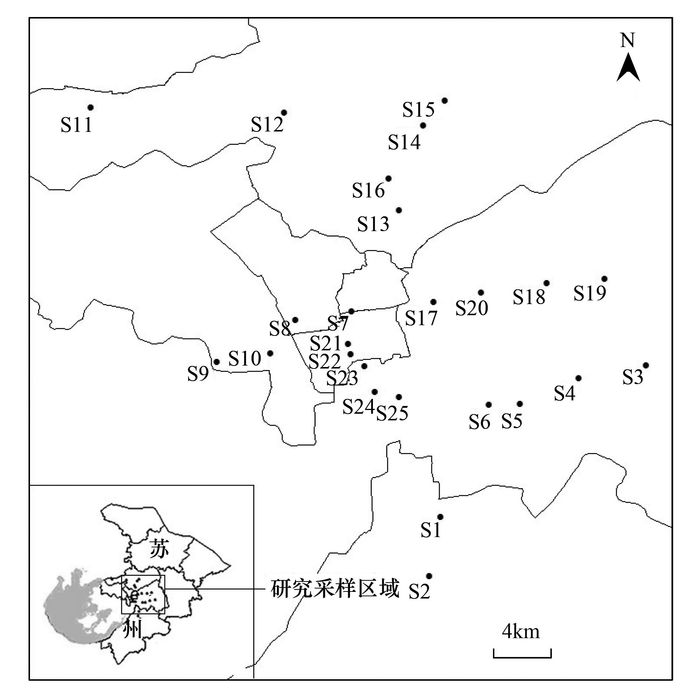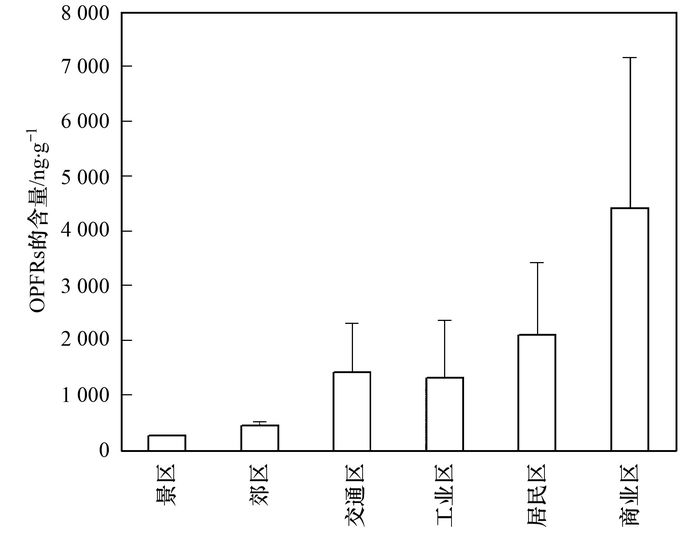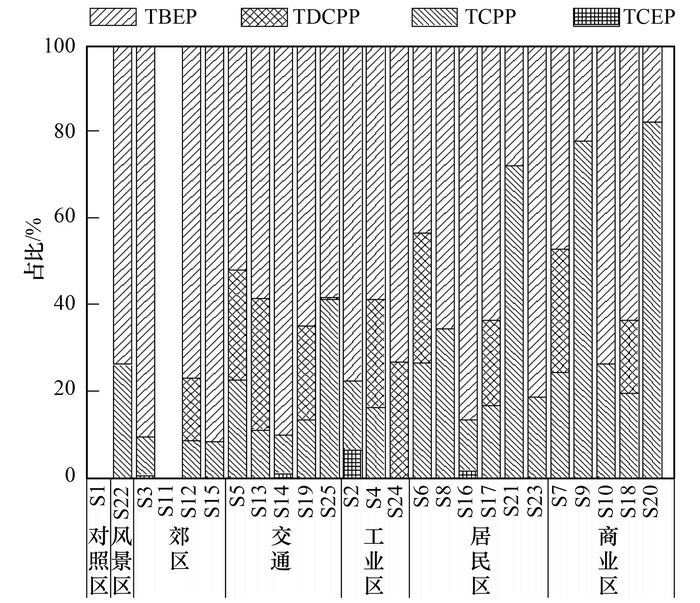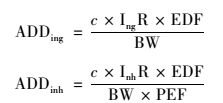2. 苏州科技大学天平学院, 苏州 215000
2. School of Tianping, Suzhou University of Science and Technology, Suzhou 215000, China
近年来有机磷阻燃剂(organophosphate flame retardants, OPFRs)作为一类重要的阻燃剂和增塑剂被广泛应用于纺织、装饰、建筑和电子设备中, 已成为溴代阻燃剂的主要替代品[1], 2010年国内有机磷阻燃剂总产量约12.5万t[2], 预计OPFRs使用量每年增长约15%[3].含氯的OPFRs常被用作阻燃剂, 如三(1-氯-2-丙基)磷酸酯[Tris(1-chloro-2-propyl) phosphate, TCPP]、磷酸三(2-氯乙基)酯[Tris(2-chloroethyl) phosphate, TCEP]和磷酸三(1, 3-二氯-2-丙基)酯[Tris(1, 3-dichloro-2-propyl) phosphate, TDCPP]作为阻燃剂添加到刚性和柔性聚氨酯泡沫中, 非含氯OPFRs常用作增塑剂, 如磷酸三(丁氧基乙基)酯[Tris(2-butoxyethyl) phosphate, TBEP]主要作为增塑剂添加到橡胶和塑料中, 添加量为聚合材料重的0.5%~8.0%之间.由于其主要以物理添加的方式与材料结合, 普遍具有较低的蒸气压和半挥发性, 在产品的生产、使用和回收处理过程中易于释放到环境中[4].目前已在室外环境如大气、大气颗粒物和灰尘[5]以及室内空气[6]、水和土壤[7~9]等介质中均检出OPFRs, 而且在生物体[10, 11]、母乳和尿液中也发现了OPFRs, 这说明OPFRs能够被生物和人类吸收代谢.有关OPFRs毒性的研究表明, 多种OPFRs具有神经毒性、生殖毒性、致癌性、基因毒性[12, 13], 尤其是本研究选择的4种OPFRs.
道路灰尘由沉积在道路上的固体颗粒组成, 被认为是从周围地区积累短期环境物质的储层[14], 而且道路灰尘一般来自路面磨损物质、车辆有关的沉积颗粒、大气和植物沉积颗粒物以及附近土壤腐蚀产物等, 道路灰尘中POPs可通过风携带或蒸发再次进入大气, 据报道马路灰尘占城市大气中PM2.5的10%以上[15].吸入扬尘对人体健康具有严重风险, 尤其对环卫工人、行人、交警等.灰尘经常被报道含有较高含量的POPs[16], 人体通过灰尘吸入产生的OPFRs的暴露也至关重要.室外大气中OPFRs来源主要是大气传输和干湿沉降, 也可能来自室内大气.空气中的OPFRs主要以分子形态悬浮在空气中或者附着在悬浮颗粒物上, 后者更为重要[17].
2016年苏州市常住人口超过1000万, 成为超大城市之一, 随着城市化和工业化发展, 其阻燃剂的使用量也急剧增加, 而且纺织业和服装业是苏州市的主要产业, 2010年纺织业从业人员超过15万人, 尽管大部分纺织业已迁出苏州市区, 但苏州仍是纺织品出口基地之一.苏州市区交通拥挤、人口密度大, 加上近年建筑施工频繁, 均可能释放大量有机磷阻燃剂.因此关于苏州地区OPFRs的污染特征和人体暴露应引起广泛关注.本研究采集了苏州市典型区域25个道路灰尘样品, 分析了道路灰尘中多种OPFRs的含量及组成, 并初步评估了不同人群通过这一途径的暴露水平.
1 材料与方法 1.1 研究区域和采样选择苏州市代表不同功能的6个城市化区域为研究区域, 包括工业园区、姑苏区、吴中区、高新区、相城区和吴江区, 松陵位于吴江与苏州市区交界处, 污染源较少, 因此选择作为对照区.考虑到工业区、商业区和居民区是城市环境中典型的功能区, 并且路边灰尘能吸附部分污染物, 根据苏州市行政区划范围内的轨道交通路线, 于2016年11月3~4日从不同区域随机采集了25个点的室外灰尘样品(见图 1), 采样面积约为2~8 m2, 市中心区域清扫频率一日2~3次, 郊区清扫频率一日一次, 每个采样点采样量约为1.0~15.0 g, 详见表 1.

|
图 1 采样点示意 Fig. 1 Map of sampling sites |
|
|
表 1 采样点信息描述 Table 1 Description of sampling sites |
灰尘的采集使用软毛刷作为采样工具[16], 采样前将软毛刷用蒸馏水洗净, 烘干后再用乙腈清洗并晾干, 用锡箔纸包裹备用.采用表面擦拭法收集路面、台阶等区域的灰尘, 每个样品分别用锡箔纸包裹放于干净的塑封袋中, 带回实验室后用不锈钢镊子去除灰尘中的砂石等, 过100目不锈钢筛后用锡箔纸包裹, 于-20℃低温避光保存.
1.2 仪器与试剂三重四级杆串联气相色谱-质谱联用仪(德国布鲁克SCION TQ), SPE固相萃取装置(12位, CNW), C-18 SPE柱(200 mg, 3 mL, CNW). 4种目标化合物标准品分别为:TDCPP、TBEP、TCEP和TCPP.替代物为氘代磷酸三丁酯(TBP-D27), 内标物为氘代磷酸三苯酯(TPhP-D15).
1.3 样品分析灰尘中OPFRs的处理方法参考已报道的固体基质中OPFRs的方法[18].准确称取灰尘样品0.1 g, 加入5 mL甲醇, 于25℃超声萃取20 min, 以4 000 r·min-1离心5 min, 静置片刻后取出上清液, 再加入5 mL萃取剂重复上述操作, 合并萃取液, 用氮吹仪氮吹至干, 1 mL正己烷回溶, 上样到已用5mL甲醇活化好的C-18柱. 10 mL超纯水淋洗小柱以去除杂质, 真空抽30 min去除水分. 10 mL乙酸乙酯进行洗脱, 将洗脱液氮吹至干用0.5 mL乙腈回溶后过0.22 μm有机相滤膜, 置于棕色进样瓶待仪器检测.
使用布鲁克气质联用仪(EI源)(GC456-SCION TQ, Bruker Daltonics Inc.)对样品中OPFRs进行分析, 选择离子检测模式(SIM), 载气为高纯氦气.选用DB-5HT(15 m×0.25 mm×0.1 μm, Agilent Technologies)毛细管柱.进样口、传输线和离子源温度分别为270℃、300℃和250℃, 不分流进样, 进样体积为1 μL.升温程序:60℃保持1 min, 以40℃·min-1升温到150℃, 保持1min, 再以20℃·min-1升温到280℃, 保持5min.载气流速为1.5 mL·min-1.
1.4 质量保证与质量控制(QA/QC)实验中每个样品进行3组平行样的测定, 每批实际样品运行1个空白样、加标空白控制实验过程中可能引入的污染.另外用空白基质加标实验控制方法的可行性, 将风景区室外灰尘样品经丙酮:二氯甲烷(1:1, 体积比)混合液浸泡后于450℃的烘箱中烘12 h以去除灰尘中有机物作为空白基质, 添加高、中、低浓度的4种OPFRs标准品制成基质加标样品, 其平均回收率为69%~135%, 在所有样品萃取前均添加已知量的替代物TPhP-D15, 其回收率为89%±15%.每个待测物的方法检出限(LODs)定义为3倍空白值的标准偏差除以每次分析灰尘的量(以0.1 g灰尘样品).灰尘样品中4种OPFRs的LODs为3~15 ng·g-1.
2 结果与讨论 2.1 OPFRs的含量水平表 2显示3种含氯OPFRs在25个采样点中有不同程度的检出, TCPP检出率为88%, TDCPP的检出率为44%, TBEP检出率为92%, 但TCEP多数未检出, 这与其他地区室外大气中含氯OPFRs的检出率相似[19].在苏州市区道路灰尘中OPFRs的总含量范围是ND~8 901.66 ng·g-1, 平均含量1 907.88 ng·g-1, 对照区未检出.苏州市区灰尘中4种OPFRs中均值最高的为TBEP, 均值为915.46 ng·g-1, 其次为TCPP, 均值为804.07 ng·g-1, 再次为TDCPP, 均值为185.09 ng·g-1; TCEP在大部分样品中未检出, 含量范围是ND~62.16 ng·g-1, 均值为3.25 ng·g-1.这可能与TCEP相对于其他待测物更易溶于水、更易挥发有关[20], 不易于积累在灰尘上.
|
|
表 2 25个室外灰尘样品中有机磷阻燃剂的含量1)/ng·g-1 Table 2 Concentrations of OPFRs in 25 outdoor dust samples/ng·g-1 |
OPFRs在水生、陆生和大气环境中出现主要由于人为活动, 尤其受城市化和工业活动的影响, 工业化和人口密集的地区将会使用更多的OPFRs, 导致更多的OPFRs释放到环境中[21].在家庭、学校、工作场所和公共场所常见的材料是OPFRs的潜在来源, 如家具、纺织品、电缆、建筑材料、绝缘材料、油漆、地板抛光和电子产品等[22].本文中不同功能区中ΣOPFRs含量从高到低顺序为商业区>居民区>交通区>工业区>郊区>景区(图 2).这也说明人类活动是OPFRs主要来源.本文中OPFRs总含量最高值出现在S9、S20和S21这3个采样点, 而S1和S11两地均未检测到OPFRs, 其原因可能在于不同采样点的功能区不同. S9近年建设大量建筑物, 导致扬尘较多, 而且分布在其附近的几个纺织品加工厂主要使用高温印染工艺, 由于OPFRs作为阻燃剂以物理添加形式加进材料中, 高温更有利于其从产品中释放, 因此该点样品中OPFRs总量最高. S20是苏州集中的商业区, 其交通量更大, 人员集中, 有更多OPFRs潜在的释放源.另外商业区相对于偏远地区其建筑物更多, 使用了含OPFRs的建筑材料或家居用品等几率更大, 则散发到外部环境中的OPFRs含量越高. S21附近分布较为集中的居民区, 人口稠密, 更多来自家庭的潜在污染源.而S1和S11两地处于苏州市区的西北和东南, 距离市区较远, 人口分布较为稀疏, 建筑物相对较少, 受到人为活动影响较小.

|
图 2 苏州市不同功能区灰尘样品中4种OPFRs的含量 Fig. 2 Concentrations of OPFRs in 25 outdoor dust samples |
与世界其它地区室内外灰尘中OPFRs对比(表 3), 苏州道路灰尘中OPFRs的含量低于欧洲、日本等地区室内微环境, 也低于我国电子垃圾拆解地和大城市, 但高于埃及和葡萄牙等地区, 与上海相当.苏州灰尘中OPFRs组成与西班牙纺织品商店相似, 均是TCEP和TCPP相对含量较高, 而与广东电子垃圾拆解地中OPFRs组成不同, 因为电子拆解地主要以TCPP为主, 而且苏州地区TCPP的含量稍高于北京、上海和新西兰等大城市, 远低于广东电子拆解地、西班牙纺织品商店和沙特汽车等.苏州地区OPFRs的主要原因可能是城市化和工业化发展, 可能主要来自纺织品和家庭日用品, 而非电子垃圾拆解业; 不同地区OPFRs的含量范围不尽相同, 与灰尘类型、采样时间和各地区OPFRs的生产、使用过程均有关.
|
|
表 3 国内外灰尘中OPFRs含量1)/ng·g-1 Table 3 Concentrations of OPFRs in dust from different regions/ng·g-1 |
2.2 OPFRs的组成
图 3显示了不同环境功能区的25个室外灰尘样品中4种OPFRs的相对贡献率, 各目标物在各采样点样品中的所占质量分数各不相同, 但组成大体一致, TCPP和TBEP是灰尘中最主要的成分, 而TCEP占比较小. OPFRs含量较高的S9、S20和S21这3个采样点均是TCPP占比较高, 而工业区、居民区以及受交通影响地区均是TBEP占比较高.各地区灰尘中OPFRs的组成模式不仅受当地的生产、使用阻燃剂的种类和数量不同的影响, 复杂的环境条件如地形和降雨量等也至关重要.

|
图 3 不同环境功能区灰尘样品中4种OPFRs的占比 Fig. 3 Percent contributions of four OPFRs in the dust samples from different environmental function areas |
人体对灰尘中OPFRs暴露可通过皮肤接触、口部直接摄入和口鼻呼吸再悬浮颗粒等途径[31].室外灰尘经呼吸途径暴露主要是被认为由风力作用导致的长期暴露.但由于缺少大气中OPFRs的浓度数据, 引入EPA推荐的颗粒物释放因子PEF, 但灰尘中部分微小颗粒能够通过空气流动迁移到大气, 成为可吸入颗粒物, 本文灰尘过100目筛(150 μm)可全部进入大气并长期停留.儿童的许多行为特点(如吮吸手指和爬行)将导致他们高暴露, 而且儿童体重小, 身体发育不完全, 对有毒有害物质耐受性低[32], 另外长期在道路上工作的环卫工人可能有更高的暴露风险.因此有必要针对儿童和环卫工人暴露OPFRs进行研究分析.本研究采用US EPA人体暴露量估算公式, 灰尘中污染物通过手口摄食途径的日暴露量(ADDing)和通过吸入途径的日暴露量(ADDinh)的计算公式为:

|
式中, c表示室外灰尘样品中每种OPFRs和ΣOPFRs的平均含量; 中暴露情况下, 成人、儿童和环卫工人对灰尘的摄入量(IngR)分别为20、50和200 mg·d-1, 高暴露情况下, 成人、儿童和环卫工人的灰尘摄入量分别为50、200和500 mg·d-1[33]; 由于缺少人体吸收OPFRs的效率数据, 假设100%吸收, 为吸收上限; 灰尘释放因子(PEF)为1.36×109 m3·kg-1[34]; 我国成年人的呼吸速率(InhR)为16.5 m3·d-1, 儿童呼吸速率为5.6 m3·d-1; 成年和幼儿(3~6岁)平均体重分别为63 kg和17.5 kg[35]; 根据苏州地区不同人群的活动情景, 儿童接触道路灰尘主要发生在儿童乘坐公共交通或私家车等上下幼儿园过程, 约为1 h·d-1, 一般成人主要发生在乘公共交通或私家车上下班过程中, 平均约为2 h·d-1, 而环卫工人工作活动时间和上下班过程可能接触道路灰尘, 平均约为10 h·d-1, 暴露持续时间(EDF)表示普通居民在室外1 d花费的时间占总时间的百分比, 所以儿童、成人和环卫工人的EDF分别为1/24 d、1/12 d和5/12 d[36].根据本文灰尘中OPFRs的含量和已报道数据, 计算不同年龄段人群对灰尘中OPFRs摄入量见表 4.
|
|
表 4 成人和儿童通过灰尘摄入和吸入OPFRs的日均暴露量/pg·kg-1 Table 4 Estimated daily intake of OPFRs via ingestion and inhalation of dust for adults and children/pg·kg-1 |
成人和儿童灰尘摄入ΣOPFRs的日均暴露量分别为50.27 pg·kg-1和228.95 pg·kg-1, 与其他城市区域人群暴露量相当, 低于电子拆解区[29].考虑到人们对灰尘防范意识不强, 导致较高灰尘摄入率, 假设在高暴露情景下, 成人和儿童摄入途径的日均暴露量分别为125.68 pg·kg-1和915.78 pg·kg-1, 儿童经过摄入途径暴露ΣOPFRs的日均暴露量约为成人的7倍.灰尘由于大气流通作用可能部分再悬浮到空气中, 人们通过口鼻呼吸进入人体, 成人和儿童通过呼吸途径暴露ΣOPFRs的日均暴露量差异不大, 但环卫工人通过呼吸途径暴露ΣOPFRs的日均暴露量为1.54E-01 pg·kg-1, 是普通成人的5倍.儿童的高暴露量可能与其日摄入率高有关, 他们暴露在室外的时间、方式和地点与成人不同, 且对灰尘的敏感度不高, 容易将自己暴露于灰尘中, 所以灰尘中OPFRs对儿童潜在威胁更大.
目前关于人体饮食摄入OPFRs的暴露途径报道较少, 仅有Zhang等[37]报道了男性和女性通过饮食摄入OPFRs的日均暴露量分别为539 ng·kg-1和601 ng·kg-1, 可能OPFRs与传统持久性有机物相似, 人体对OPFRs的暴露主要通过饮食摄入, 但还需要考虑地域和饮食习惯等不同.
3 结论(1) OPFRs在苏州典型区域室外灰尘中普遍存在, 其OPFRs含量与上海、北京等大城市含量相当.苏州道路灰尘中OPFRs组成以TBEP为主, 其次为TCPP.
(2) 人为活动对当地环境中的OPFRs影响较大, 城市化和工业化程度较高地区的OPFRs含量较高, 而位于郊区、人类活动较少地区则相反.不同功能区灰尘中OPFRs组成模式不同, TBEP可能来自室内消费品和家用品.
(3) 灰尘是当地人群尤其是儿童暴露OPFRs的重要途径之一, 在高暴露情景下, 儿童通过灰尘摄入途径的OPFRs日均暴露量约为成人的7倍, 儿童通过口鼻呼吸再悬浮颗粒物暴露OPFRs的日均暴露量与普通成人相差不大, 但儿童身体耐受性低, 因此儿童通过灰尘摄入OPFRs的风险更大.环卫工人等室外工作群体在没有防护措施的情形下通过灰尘摄入和口鼻呼吸均会导致较高OPFRs暴露量, 存在较大健康风险.
| [1] |
王晓伟, 刘景富, 阴永光. 有机磷酸酯阻燃剂污染现状与研究进展[J]. 化学进展, 2010, 22(10): 1983-1992. Wang X W, Liu J F, Yin Y G. The pollution status and research progress on organophosphate ester flame retardants[J]. Progress in Chemistry, 2010, 22(10): 1983-1992. |
| [2] | 中国聚合物网. 聚氨酯等使全球有机磷阻燃剂增速达20%[EB/OL]. (2010-10-19). http://www.polymer.cn/polymernews/2010-10-19/_20101019161904168.htm. |
| [3] |
欧育湘. 我国有机磷阻燃剂产业的分析与展望[J]. 化工进展, 2011, 30(1): 210-215. Ou Y X. Developments of organic phosphorus flame retardant industry in China[J]. Chemical Industry and Engineering Progress, 2011, 30(1): 210-215. |
| [4] | Wei G L, Li D Q, Zhuo M N, et al. Organophosphorus flame retardants and plasticizers: sources, occurrence, toxicity and human exposure[J]. Environmental Pollution, 2015, 196: 29-46. DOI:10.1016/j.envpol.2014.09.012 |
| [5] | Liu R R, Lin Y F, Liu R Z, et al. Evaluation of two passive samplers for the analysis of organophosphate esters in the ambient air[J]. Talanta, 2016, 147: 69-75. DOI:10.1016/j.talanta.2015.09.034 |
| [6] | Mizouchi S, Ichiba M, Takigami H, et al. Exposure assessment of organophosphorus and organobromine flame retardants via indoor dust from elementary schools and domestic houses[J]. Chemosphere, 2015, 123: 17-25. DOI:10.1016/j.chemosphere.2014.11.028 |
| [7] | Marklund A, Andersson B, Haglund P. Organophosphorus flame retardants and plasticizers in Swedish sewage treatment plants[J]. Environmental Science & Technology, 2005, 39(19): 7423-7429. |
| [8] | Hu M Y, Li J, Zhang B B, et al. Regional distribution of halogenated organophosphate flame retardants in seawater samples from three coastal cities in China[J]. Marine Pollution Bulletin, 2014, 86(1-2): 569-574. DOI:10.1016/j.marpolbul.2014.06.009 |
| [9] | Wan W N, Zhang S Z, Huang H L, et al. Occurrence and distribution of organophosphorus esters in soils and wheat plants in a plastic waste treatment area in China[J]. Environmental Pollution, 2016, 214: 349-353. DOI:10.1016/j.envpol.2016.04.038 |
| [10] | Jonsson O B, Dyremark E, Nilsson U L. Development of a microporous membrane liquid-liquid extractor for organophosphate esters in human blood plasma: identification of triphenyl phosphate and octyl diphenyl phosphate in donor plasma[J]. Journal of Chromatography B: Biomedical Sciences and Applications, 2001, 755(1-2): 157-164. DOI:10.1016/S0378-4347(01)00055-X |
| [11] | Liu L Y, Salamova A, He K, et al. Analysis of polybrominated diphenyl ethers and emerging halogenated and organophosphate flame retardants in human hair and nails[J]. Journal of Chromatography A, 2015, 1406: 251-257. DOI:10.1016/j.chroma.2015.06.003 |
| [12] |
王伟, 耿存珍. 室内环境中的有机磷酸酯及环境毒理研究[J]. 环境科学与管理, 2015, 40(10): 85-88. Wang W, Geng C Z. Organophosphate esters in indoor environment and its environmental toxicology[J]. Environmental Science and Management, 2015, 40(10): 85-88. DOI:10.3969/j.issn.1673-1212.2015.10.020 |
| [13] | Chen G L, Jin Y X, Wu Y, et al. Exposure of male mice to two kinds of organophosphate flame retardants (OPFRs) induced oxidative stress and endocrine disruption[J]. Environmental Toxicology and Pharmacology, 2015, 40(1): 310-318. DOI:10.1016/j.etap.2015.06.021 |
| [14] | Tang R L, Ma K M, Zhang Y X, et al. The spatial characteristics and pollution levels of metals in urban street dust of Beijing, China[J]. Applied Geochemistry, 2013, 35: 88-98. DOI:10.1016/j.apgeochem.2013.03.016 |
| [15] | Yu L D, Wang G F, Zhang R J, et al. Characterization and source apportionment of PM2.5 in an urban environment in Beijing[J]. Aerosol and Air Quality Research, 2013, 13(2): 574-583. |
| [16] | Xu F, Liu Y C, Wang J X, et al. Characterization of heavy metals and brominated flame retardants in the indoor and outdoor dust of e-waste workshops: implication for on-site human exposure[J]. Environmental Science and Pollution Research, 2015, 22(7): 5469-5480. DOI:10.1007/s11356-014-3773-z |
| [17] | Cao Z G, Xu F C, Covaci A, et al. Distribution patterns of brominated, chlorinated, and phosphorus flame retardants with particle size in indoor and outdoor dust and implications for human exposure[J]. Environmental Science & Technology, 2014, 48(15): 8839-8846. |
| [18] | van den Eede N, Dirtu A C, Ali N, et al. Multi-residue method for the determination of brominated and organophosphate flame retardants in indoor dust[J]. Talanta, 2012, 89: 292-300. DOI:10.1016/j.talanta.2011.12.031 |
| [19] | Zhou L L, Hiltscher M, Gruber D, et al. Organophosphate flame retardants (OPFRs) in indoor and outdoor air in the Rhine/Main area, Germany: comparison of concentrations and distribution profiles in different microenvironments[J]. Environmental Science and Pollution Research, 2017, 24(12): 10992-11005. DOI:10.1007/s11356-016-6902-z |
| [20] | van den Veen I, De Boer J. Phosphorus flame retardants: properties, production, environmental occurrence, toxicity and analysis[J]. Chemosphere, 2012, 88(10): 1119-1153. DOI:10.1016/j.chemosphere.2012.03.067 |
| [21] | Regnery J, Püttmann W. Occurrence and fate of organophosphorus flame retardants and plasticizers in urban and remote surface waters in Germany[J]. Water Research, 2010, 44(14): 4097-4104. DOI:10.1016/j.watres.2010.05.024 |
| [22] | Cristale J, Hurtado A, Gómez-Canela C, et al. Occurrence and sources of brominated and organophosphorus flame retardants in dust from different indoor environments in Barcelona, Spain[J]. Environmental Research, 2016, 149: 66-76. DOI:10.1016/j.envres.2016.05.001 |
| [23] | Ali N, Dirtu A C, Eede N V D, et al. Occurrence of alternative flame retardants in indoor dust from New Zealand: indoor sources and human exposure assessment[J]. Chemosphere, 2012, 88(11): 1276-1282. DOI:10.1016/j.chemosphere.2012.03.100 |
| [24] | Abdallah M A E, Covaci A. Organophosphate flame retardants in indoor dust from Egypt: implications for human exposure[J]. Environmental Science & Technology, 2014, 48(9): 4782-4789. |
| [25] | Marklund A, Andersson B, Haglund P. Screening of organophosphorus compounds and their distribution in various indoor environments[J]. Chemosphere, 2003, 53(9): 1137-1146. DOI:10.1016/S0045-6535(03)00666-0 |
| [26] | Ali N, Eqani S A M A S, Ismail I M I, et al. Brominated and organophosphate flame retardants in indoor dust of Jeddah, Kingdom of Saudi Arabia: implications for human exposure[J]. Science of the Total Environment, 2016, 569 -570: 269-277. DOI:10.1016/j.scitotenv.2016.06.093 |
| [27] | Coelho S D, Sousa A C, Isobe T, et al. Brominated, chlorinated and phosphate organic contaminants in house dust from Portugal[J]. Science of the Total Environment, 2016, 569 -570: 442-449. DOI:10.1016/j.scitotenv.2016.06.137 |
| [28] | Wu M, Yu G, Cao Z G, et al. Characterization and human exposure assessment of organophosphate flame retardants in indoor dust from several microenvironments of Beijing, China[J]. Chemosphere, 2016, 150: 465-471. DOI:10.1016/j.chemosphere.2015.12.111 |
| [29] | He C T, Zheng J, Qiao L, et al. Occurrence of organophosphorus flame retardants in indoor dust in multiple microenvironments of southern China and implications for human exposure[J]. Chemosphere, 2015, 133: 47-52. DOI:10.1016/j.chemosphere.2015.03.043 |
| [30] |
鹿建霞, 季雯, 马盛韬, 等. 气相色谱/质谱法检测灰尘、土壤和沉积物中有机磷酸酯[J]. 分析化学, 2014, 42(6): 859-865. Lu J X, Ji W, Ma S T, et al. Analysis of organophosphate esters in dust, soil and sediment samples using gas chromatography coupled with mass spectrometry[J]. Chinese Journal of Analytical Chemistry, 2014, 42(6): 859-865. |
| [31] |
丁锦建. 典型有机磷阻燃剂人体暴露途径与蓄积特征研究[D]. 杭州: 浙江大学, 2016. Ding J J. Study on human exposure pathways and accumulation characteristics of typical organophosphate flame retardants[D]. Hangzhou: Zhejiang University, 2016. http://cdmd.cnki.com.cn/Article/CDMD-10335-1016118136.htm |
| [32] |
王璟, 陈社军, 田密, 等. 电子废弃物处理地室内外灰尘中多溴联苯醚的污染及其人群暴露水平[J]. 环境科学, 2010, 31(1): 173-178. Wang J, Chen S J, Tian M, et al. Polybrominated diphenyl ethers (PBDEs) in indoor and outdoor dust from an electronic waste (e-waste) recycling area in south China: contamination and human exposure[J]. Environmental Science, 2010, 31(1): 173-178. |
| [33] | Van den Eede N, Dirtu A C, Neels H, et al. Analytical developments and preliminary assessment of human exposure to organophosphate flame retardants from indoor dust[J]. Environment International, 2011, 37(2): 454-461. DOI:10.1016/j.envint.2010.11.010 |
| [34] | US EPA. Supplemental guidance for developing soil screening levels for superfund sites[R]. Washington DC: United States Environmental Protection Agency, 2002. |
| [35] |
王宗爽, 段小丽, 刘平, 等. 环境健康风险评价中我国居民暴露参数探讨[J]. 环境科学研究, 2009, 22(10): 1164-1170. Wang Z S, Duan X L, Liu P, et al. Human exposure factors of Chinese people in environmental health risk assessment[J]. Research of Environmental Sciences, 2009, 22(10): 1164-1170. |
| [36] | Cao Z G, Zhao L C, Kuang J M, et al. Vehicles as outdoor BFR sources: evidence from an investigation of BFR occurrence in road dust[J]. Chemosphere, 2017, 179: 29-36. DOI:10.1016/j.chemosphere.2017.03.095 |
| [37] | Zhang X L, Zou W, Mu L, et al. Rice ingestion is a major pathway for human exposure to organophosphate flame retardants (OPFRs) in China[J]. Journal of Hazardous Materials, 2016, 318: 686-693. DOI:10.1016/j.jhazmat.2016.07.055 |
 2017, Vol. 38
2017, Vol. 38


